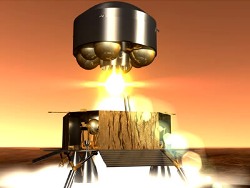Missions to Mars: Mars Sample Return
The most challenging mission to Mars yet
The Sample Return mission is now planned for 2020-2024 and will be the most challenging mission to Mars so far in terms of technology. The goal is to take sample of the surface, the rocks and the atmosphere of Mars and to bring these samples safe and intact back to Earth

|
By “intact”, scientists mean that the samples must be preserved in exactly the same conditions as those in which they were found on Mars (temperature and pressure).
This is necessary to prevent any changes in the samples that could affect the outcome of scientific analysis to test for evidence of past or present life.
|
The Involvement of the Royal Belgian Institute for Space Aeronomy (BIRA-IASB)
Scientists Frank Daerden and Christian Muller from BIRA-IASB are members from the international working team iMARS, who are preparing a Mars Sample Return mission and who won a NASA Group Achievement Award in 2009 for their services.
Problems and challenges
The scientific community thought of bringing samples from Mars back to Earth a long time ago, since subjecting them to varied and complex analyses is so much easier in the various sophisticated research laboratories here on Earth.
The spacecraft that man can send to Mars (landers or rovers), can only carry a few instruments and tools to analyse the surface and the atmosphere. If intact Mars samples were available on Earth the number of possible ways to study them would be far more wide-reaching and thus more informative.
- From a technological point of view the MSR-mission is a challenge that concerns both the collection and preservation of the samples and planetary protection. MSR would leave Earth with not only a rover to take samples but also a transport system to launch the samples back into Mars orbit and then bring them back to Earth. At this time, this can only be managed with two different rocket launches: one to send the rover to Mars and one to send the spacecraft for the return journey. This means a rendez-vous would need to occur in Mars orbit..
- Keeping the samples in exactly the same conditions from the Mars surface to a lab on Earth is also extremely difficult, given the huge variations in temperature and pressure that they undergo at launch, in Mars orbit and during an interplanetary flight back to Earth. They must also survive atmospheric re-entry at Earth and be collected from wherever they land to be shared out to various research laboratories.
- Lastly, planetary protection is also a crucial issue. We must not only avoid the contamination of the Mars surface with any organisms (bacteria) from Earth, but also the contamination of the samples. After all the conclusion from a laboratory on Earth that finds organic material in a sample from mars must not then by subject to the question: is there really life on mars, or were the samples contaminated, on mars, on board the spacecraft, or on Earth?? And of course, the Earth’s biosphere must also be protected from any possible Mars life forms.
|

